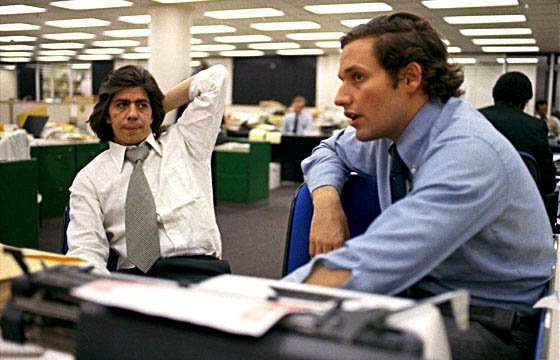Carl Bernstein on rewind
Carl Bernstein (left) and Bob Woodward
The stink of tobacco, sweat and stale beer still lingers after I spent too many hours in the kinetic newsroom of the Washington Star, peering out from the eyes of Carl Bernstein. The reporter famous for Watergate has written a memoir of his five-year apprenticeship at the afternoon daily, starting in 1960. The bittersweet recollections in Chasing History: A Kid in the Newsroom are amply augmented with research from old notebooks, new interviews and yellowed clippings. Rather than being drawn into his deep nostalgia, though, I found myself overwhelmed by detail.
In a recent interview with the New York Times, Bernstein called the book “a road map of how you do reporting. It’s not about looking things up on the Internet. It’s what we need to be doing now, which is knocking on doors, getting out into the community we cover.”
There was a lot of door-knocking at the Washington Star (which died bankrupt in 1980). And a lot of drinking – before, during and after work. Beat reporters hung out with key players, plugged in and being plugged, in bars and restaurants. Those days now seem quaint. Politicians and others have dug themselves a wide moat, using flacks, social media and the police. Knocking on doors could get you arrested. And today’s understaffed newsrooms leave scant room for shoe-leather reporting.
Bernstein’s disdain for the Internet is understandable. The web was science fiction in his reporting days, and good human sources were (and remain) gold. Face-to-face is always preferable to texts, emails and voice-messages. But the digital age has also opened vast journalistic territories that door-knocking can’t touch, witness the Panama Papers and other data-driven investigations. The U.S. Freedom of Information Act, passed in 1966, was also absent from Bernstein’s toolkit. FOI has cultivated a brave new branch of trenchant journalism.
The Washington Star was a newsroom reflecting a Jim Crow town. Sixty per cent of residents were Black, yet not a single Black journalist was on staff when Bernstein signed up. His memoir lauds the newspaper’s coverage of civil-rights marches, but the all-white reporting staff poisons the nostalgia.
A few crackerjack women reporters make their mark at the paper, but none are running the place. Bernstein’s ambitious girlfriend graduates from the newspaper’s training program, and is immediately shuffled into the “Women’s Department” to cover fashion shows and furniture fairs.
The Bernstein in Chasing History is an eager teenager working hard to fit in. As a copy boy, he studiously learned the craft from mentors, all older men (though he never became a Washington Star reporter because he lacked a college degree). Those early skills – which he calls investigative reporting – served him well during the Watergate scandal (1972-1974), after he had joined the rival Washington Post. But the memoir, a loving account of a time and place, is no road map for our own.
Carl Bernstein, Chasing History: A Kid in the Newsroom (Henry Holt and Company, New York: 2022), 370 pages, HC.
Jan. 30, 2022

